Variety Screening and Characterization Analysis of Storage Stability of Eating Quality of Rice
Abstract
1. Introduction
2. Materials and Methods
2.1. Experimental Material
2.2. Experimental Site and Weather Conditions
2.3. Experimental Design
2.4. Sampling and Measurement
2.4.1. Eating Quality
2.4.2. Grain Yield and Its Composition
2.4.3. Key Growth Stages of Rice
2.4.4. Grain Size
2.4.5. Major Component Content in Grains
2.4.6. Physiological Indicator
2.5. Formulas and Statistical Analysis
2.5.1. Variable Amplitude of the Eating Quality of Rice
2.5.2. Comprehensive Evaluation
- (1)
- Storage stability score calculation
- (2)
- Weighted value of the storage stability score of the eating quality
- (3)
- Calculating the eating quality storage stability index
2.5.3. Statistical Analysis
3. Results and Discussion
3.1. Variable Amplitude
3.2. Screening of Rice Varieties
3.2.1. Construction of the Comprehensive Evaluation Index System
3.2.2. Eating Quality Storage Stability Index
3.2.3. Screening of Rice Varieties with High Storage Stability for Eating Quality
3.3. Characteristics of Rice Varieties with High Storage Stability
4. Conclusions
Supplementary Materials
Author Contributions
Funding
Institutional Review Board Statement
Informed Consent Statement
Data Availability Statement
Acknowledgments
Conflicts of Interest
Correction Statement
References
- Wing, R.A.; Purugganan, M.D.; Zhang, Q.F. The rice genome revolution: From an ancient grain to Green Super Rice. Nat. Rev. Genet. 2018, 19, 505–517. [Google Scholar] [CrossRef] [PubMed]
- Yan, Y.; Zhu, X.Y.; Qi, H.; Wang, Y.; Zhang, H.Q.; He, J.W. Rice seed storability: From molecular mechanisms to agricultural practices. Plant Sci. 2024, 348, 112215. [Google Scholar] [CrossRef] [PubMed]
- Fei, Y.X.; Cao, Y.J.; Wu, M.; Wu, H.K. Research Progress and Prospect on the Mechanism of Rice Grain Storage Quality Deterioration. China Rice 2018, 24, 22–26. [Google Scholar] [CrossRef]
- Wang, H.W.; Wang, Y.; Wang, R.; Liu, X.L.; Zhang, Y.Y.; Zhang, H.; Chi, C.D. Impact of long-term storage on multi-scale structures and physicochemical properties of starch isolated from rice grains. Food Hydrocoll. 2022, 124, 107255. [Google Scholar] [CrossRef]
- Zhou, Z.; Robards, K.; Helliwell, S.; Blanchard, C. Ageing of Stored Rice: Changes in Chemical and Physical Attributes. J. Cereal Sci. 2002, 35, 65–78. [Google Scholar] [CrossRef]
- Deng, B.W.; Zhang, Y.N.; Zhang, F.; Wang, W.S.; Xu, J.L.; Zhang, Y.; Bao, J.S. Genome-Wide Association Study of Cooked Rice Textural Attributes and Starch Physicochemical Properties in indica Rice. Rice Sci. 2024, 31, 300–316. [Google Scholar] [CrossRef]
- Gu, Y.; Tong, C.; Hu, Y.Q.; Liu, L.; Bao, J.S. Starch lysophospholipids contents affect storage quality of paddy rice. Carbohydr. Polym. 2025, 348, 122818. [Google Scholar] [CrossRef]
- Ma, Y.; Sun, D.W. Hardness of cooked rice as affected by varisties, cooling methods and chill storage. J. Food Process Eng. 2009, 32, 161–176. [Google Scholar] [CrossRef]
- Zhou, Z.K.; Robards, K.; Helliwell, S.; Blanchard, C. Effect of storage temperature on rice thermal properties. Food Res. Int. 2010, 43, 709–715. [Google Scholar] [CrossRef]
- Zhou, X.Q.; Zhu, F.Q.; Zhang, Y.R.; Peng, C. Analysis of the Storage Property, Physiological, Biochemical Indicators Parameters and the Pasting Characteristics of Rice in Different Storage Time. J. Chin. Cereals Oils Assoc. 2020, 35, 108–114. Available online: http://www.lyxuebao.net/ch/reader/view_abstract.aspx?file_no=20200117&flag=1 (accessed on 17 December 2024).
- Zhou, T.S.; Yu, D.; Wu, L.B.; Xu, Y.S.; Duan, M.J.; Yuan, D.Y. Seed Storability in Rice: Physiological Bases, Molecular Mechanisms, and Application to Breeding. Rice Sci. 2024, 31, 401–416. [Google Scholar] [CrossRef]
- Zhu, D.Y.; Wang, T.T.; Liu, X.Y.; Bi, J.; Zhang, W.; Zeng, X.F.; Wang, P.P.; Shu, Z.X. Quality changes in Chinese high-quality indica rice under different storage temperatures with varying initial moisture contents. Front. Nutr. 2024, 11, 1334809. [Google Scholar] [CrossRef] [PubMed]
- Wang, F.X.; Xu, H.B.; Zhang, L.; Shi, Y.R.; Song, Y.; Wang, X.Y.; Cai, Q.H.; He, W.; Xie, H.A.; Zhang, J.F. The lipoxygenase OsLOX10 affects seed longevity and resistance to saline-alkaline stress during rice seedlings. Plant Mol. Biol. 2023, 111, 415–428. [Google Scholar] [CrossRef] [PubMed]
- Qu, C.L.; Xia, Y.Z.; Yang, Q.K.; Li, W.H.; Hu, M.; Lu, P. Novel insights into rice deterioration for nitrogen controlled atmosphere and re-aeration storage based on no-targeted metabolomics. LWT-Food Sci. Technol. 2023, 178, 114631. [Google Scholar] [CrossRef]
- Yuan, B.; Zhao, C.J.; Yan, M.; Huang, D.C.; David Julian, M.C.; Huang, Z.G.; Cao, C.J. Influence of gene regulation on rice quality: Impact of storage temperature and humidity on flavor profile. Food Chem. 2019, 283, 141–147. [Google Scholar] [CrossRef]
- Kaminski, T.A.; Brackmann, A.; Da Silva, L.P.; Nicoletti, A.M.; Roberto, B.S. Changes in culinary, viscoamylographic and sensory characteristics during rice storage at different temperatures. J. Stored Prod. Res. 2013, 53, 37–42. [Google Scholar] [CrossRef]
- Brizzolara, S.; Manganaris, G.A.; Fotopoulos, V.; Watkins, C.B.; Tonutti, P. Primary Metabolism in Fresh Fruits During Storage. Front. Plant Sci. 2020, 11, 80. [Google Scholar] [CrossRef]
- GB/T17891-2017; General Administration of Quality Supervision. Inspection and Quarantine of the People’s Republic of China: Beijing, China, 2017.
- Das, K.; Panda, B.B.; Shaw, B.P.; Das, S.R.; Dash, S.K.; Kariali, E.; Mohapatra, P.K. Grain density and its impact on grain filling characteristic of rice: Mechanistic testing of the concept in genetically related cultivars. Sci. Rep. 2018, 8, 4149. [Google Scholar] [CrossRef]
- Kohaich, K.; Baaziz, M. New investigations on the guaiacol peroxidase of Opuntia ficus indica L. and its modulation by ascorbic acid and copper. Towards an optimization of quantitative and qualitative tests. J. Mol. Catal. B Enzym. 2015, 119, 26–32. [Google Scholar] [CrossRef]
- Prokopiv, T.M.; Fedorovych, D.V.; Boretsky, Y.R.; Sibirny, A.A. Oversynthesis of Riboflavin in the Yeast Pichia guilliermondii is Accompanied by Reduced Catalase and Superoxide Dismutases Activities. Curr. Microbiol. 2013, 66, 79–87. [Google Scholar] [CrossRef]
- Wei, H.Y.; Zhang, H.C.; Qun, M.; Dai, Q.G.; Huo, Z.Y.; Xu, K.; Zhang, Q.; Huang, L.F. Characteristics of Leaf Senescence in Rice Genotypes with Different Nitrogen Use Efficiencies. Acta Agron. Sin. 2010, 36, 645–654. [Google Scholar] [CrossRef]
- Wood, I.; Trostchansky, A.; Rubbo, H. Structural considerations on lipoxygenase function, inhibition and crosstalk with nitric oxide pathways. Biochimie 2020, 178, 170–180. [Google Scholar] [CrossRef] [PubMed]
- Thrikawala, V.S.; Deraniyagala, S.A.; Dilanka Fernando, C.; Udukala, D.N. In Vitro α-Amylase and Protein Glycation Inhibitory Activity of the Aqueous Extract of Flueggea leucopyrus Willd. J. Chem. 2018, 2018, 2787138. [Google Scholar] [CrossRef]
- Liu, Q.Y.; Zhou, L.; Tian, J.Y.; Cheng, S.; Tao, Y.; Xing, Z.P.; Liu, G.D.; Wei, H.Y.; Zhang, H.C. Comprehensive Evaluation of Nitrogen Efficiency and Screening of Varieties with High Grain Yield and High Nitrogen Efficiency of Inbred Middle-Ripe Japonica Rice in the Middle and Lower Reaches of Yangtze River. Sci. Agric. Sin. 2021, 54, 1397–1409. [Google Scholar] [CrossRef]
- Zhou, N.B. Effects of Temperature and Light Factors on Yield, Nitrogen Uptake and Utilization and Quality of High-Quality Rice in the Lower Reaches of Huai River Basin. Ph.D. Thesis, Yangzhou University, Yangzhou, China, 2021. [Google Scholar]
- Huang, Y.C.; Lai, H.M. Characteristics of the starch fine structure and pasting properties of waxy rice during storage. Food Chem. 2014, 152, 432–439. [Google Scholar] [CrossRef]
- Tamura, M.; Shinohe-Oshima, M.; Saito, T. Performance of non-waxy Japonica rice in the post-cooking storage process and with a varying water-to-rice ratio. Appl. Food Res. 2024, 4, 100366. [Google Scholar] [CrossRef]
- Ohno, T.; Ohisa, N. Studies on Textural and Chemical Changes in Aged Rice Grains. Food Sci. Technol. Res. 2005, 11, 385–389. [Google Scholar] [CrossRef]
- Tian, J.Y.; Xing, Z.P.; Li, S.P.; Cheng, S.; Guo, B.W.; Hu, Y.J.; Wei, H.Y.; Gao, H.; Zhang, Z.Z.; Fan, P.; et al. Influence of Wheat Straw Return on Yield and Grain Quality in Different Direct-Seeding Rice Production Systems. Agronomy 2022, 12, 3180. [Google Scholar] [CrossRef]
- Fan, P.; Yang, T.L.; Zhu, S.L.; Wang, Z.J.; Zhang, M.Y.; Wei, H.Y.; Liu, G.D. Preliminary Study on Appearance Quality Evaluation of Semi-Waxy Rice in Yangtze River Delta Region. Sci. Agric. Sin. 2024, 57, 3105–3116. [Google Scholar] [CrossRef]
- Lin, H.M.; Du, Z.F. Some Problems in Comprehensive Evaluation in the Principal Component Analysis. Stat. Res. 2013, 30, 25–31. [Google Scholar] [CrossRef]
- Cretin, G.; Galochkina, T.; Vander Meersche, Y.; De Brevern, A.G.; Postic, G.; Gelly, J.C. SWORD2: Hierarchical analysis of protein 3D structures. Nucleic Acids Res. 2022, 50, W732–W738. [Google Scholar] [CrossRef] [PubMed]
- Zhang, Z.Z. Study on Comprehensive Productivity and Temperatureand Solar Radiation Utilization Characteristics of LateSowing Rice Stubble Wheat in Different Wheat Regions. Ph.D. Thesis, Yangzhou University, Yangzhou, China, 2023. [Google Scholar]
- Chen, W.Q.; Wang, J.Z.; Cao, X.Y.; Ran, H.F.; Teng, D.X.; Chen, J.; He, X.; Zheng, X. Possibility of using multiscale normalized difference vegetation index data for the assessment of total suspended solids (TSS) concentrations in surface water: A specific case of scale issues in remote sensing. Environ. Res. 2021, 194, 110636. [Google Scholar] [CrossRef] [PubMed]
- Shen, J.; Cai, Y.; He, Y.T.; Li, Q.Q.; Du, X.Y.; Wang, C.Q.; Luo, D.Q. Dynamic Simulation of Dry Matter Accumulation in Flue-cured Tobacco and Analysis of Its Characteristics Based on Normalized Method. Acta Agron. Sin. 2017, 43, 442–453. [Google Scholar] [CrossRef]
- Okamura, M.; Arai-Sanoh, Y.; Yoshida, H.; Mukouyama, T.; Adachi, S.; Yabe, S.; Nakagawa, H.; Tsutsumi, K.; Taniguchi, Y.; Kobayashi, N.; et al. Characterization of high-yielding rice cultivars with different grain-filling properties to clarify limiting factors for improving grain yield. Field Crops Res. 2018, 219, 139–147. [Google Scholar] [CrossRef]
- Zhang, J.; Zhang, Y.Y.; Song, N.Y.; Chen, Q.L.; Sun, H.Z.; Peng, T.; Huang, S.; Zhao, Q.Z.Y. Response of grain filling rate and grain quality of mid-season indica rice to nitrogen application. J. Integr. Agric. 2021, 20, 1465–1473. [Google Scholar] [CrossRef]
- Zhou, T.Y.; Li, Z.K.; Li, E.P.; Wang, W.L.; Yuan, L.M.; Zhang, H.; Liu, L.J.; Wang, Z.Q.; Gu, J.F.; Yang, J.C. Optimization of nitrogen fertilization improves rice quality by affecting the structure and physicochemical properties of starch at high yield levels. J. Integr. Agric. 2022, 21, 1576–1592. [Google Scholar] [CrossRef]
- Joseph, C.; Zigrida, Z. Changes in peptide subunit composition of albumins, globulins, prolamins, and oryzenin in maturing rice grains. J. Agric. Food Chem. 1994, 42, 2152–2155. [Google Scholar] [CrossRef]
- Zheng, X.H.; Yuan, Z.Y.; Yu, Y.Y.; Yu, S.B.; He, H.Z. OsCSD2 and OsCSD3 Enhance Seed Storability by Modulating Antioxidant Enzymes and Abscisic Acid in Rice. Plants 2024, 13, 310. [Google Scholar] [CrossRef]
- Guo, L.; Yang, S.Y.; Tu, Z.H.; Yu, F.Y.; Qiu, C.Q.; Huang, G.J.; Fang, S. An indole-3-acetic acid inhibitor mitigated mild cadmium stress by suppressing peroxide formation in rice seedling roots. Plant Physiol. Biochem. 2024, 213, 108823. [Google Scholar] [CrossRef]
- Jiang, J.; Zhuang, J.Y.; Fan, Y.Y.; Shen, B. Mapping of QTLs for Leaf Malondialdehyde Content Associated with Stress Tolerance in Rice. Rice Sci. 2009, 16, 72–74. [Google Scholar] [CrossRef]
- Li, F.; Wu, X.J.; Wu, W. Effects of oxidative modification by malondialdehyde on the in vitro digestion properties of rice bran protein. J. Cereal Sci. 2021, 97, 103158. [Google Scholar] [CrossRef]
- Zhang, D.; Huang, S.S.; Wang, Q.; Shang, B.; Liu, J.L.; Xing, X.T.; Hong, Y.; Liu, H.; Duan, X.L.; Sun, H. Lipidomics and volatilomics reveal the changes in lipids and their volatile oxidative degradation products of brown rice during accelerated aging. Food Chem. 2023, 421, 136157. [Google Scholar] [CrossRef] [PubMed]
- Liu, X.; Wang, W.F.; Li, Z.; Xu, L.; Lan, D.M.; Wang, Y.H. Lipidomics analysis unveils the dynamic alterations of lipid degradation in rice bran during storage. Food Res. Int. 2024, 184, 114243. [Google Scholar] [CrossRef] [PubMed]
- Lin, S.K.; Wu, T.; Lin, H.L.; Zhang, Y.Q.; Xu, S.C.; Wang, J.G.; Wu, B.S.; Chen, Y.; Lin, S.Y.; Lin, D.H.; et al. De Novo Analysis Reveals Transcriptomic Responses in Eriobotrya japonica Fruits during Postharvest Cold Storage. Genes 2018, 9, 639. [Google Scholar] [CrossRef]
- Zhao, Q.Y.; Yousaf, L.; Xue, Y.; Shen, Q. Changes in flavor of fragrant rice during storage under different conditions. J. Sci. Food Agric. 2020, 100, 3435–3444. [Google Scholar] [CrossRef]
- Barbosa, N.C.; Mendonça Vieira, R.A.; Resende, E.D.d. Modeling the respiration rate of Golden papayas stored under different atmosphere conditions at room temperature. Postharvest Biol. Technol. 2018, 136, 152–160. [Google Scholar] [CrossRef]
- Sun, S.G.; Li, B.P.; Yang, T.; Luo, F.J.; Zhao, J.H.; Cao, J.Z.; Lin, Q. Preservation mechanism of high concentration carbon dioxide controlled atmosphere for paddy rice storage based on quality analyses and molecular modeling tools. J. Cereal Sci. 2019, 85, 279–285. [Google Scholar] [CrossRef]
- Nawaz, M.A.; Fukai, S.; Prakash, S.; Bhandari, B. Effects of three types of modified atmospheric packaging on the physicochemical properties of selected glutinous rice. J. Stored Prod. Res. 2018, 76, 85–95. [Google Scholar] [CrossRef]
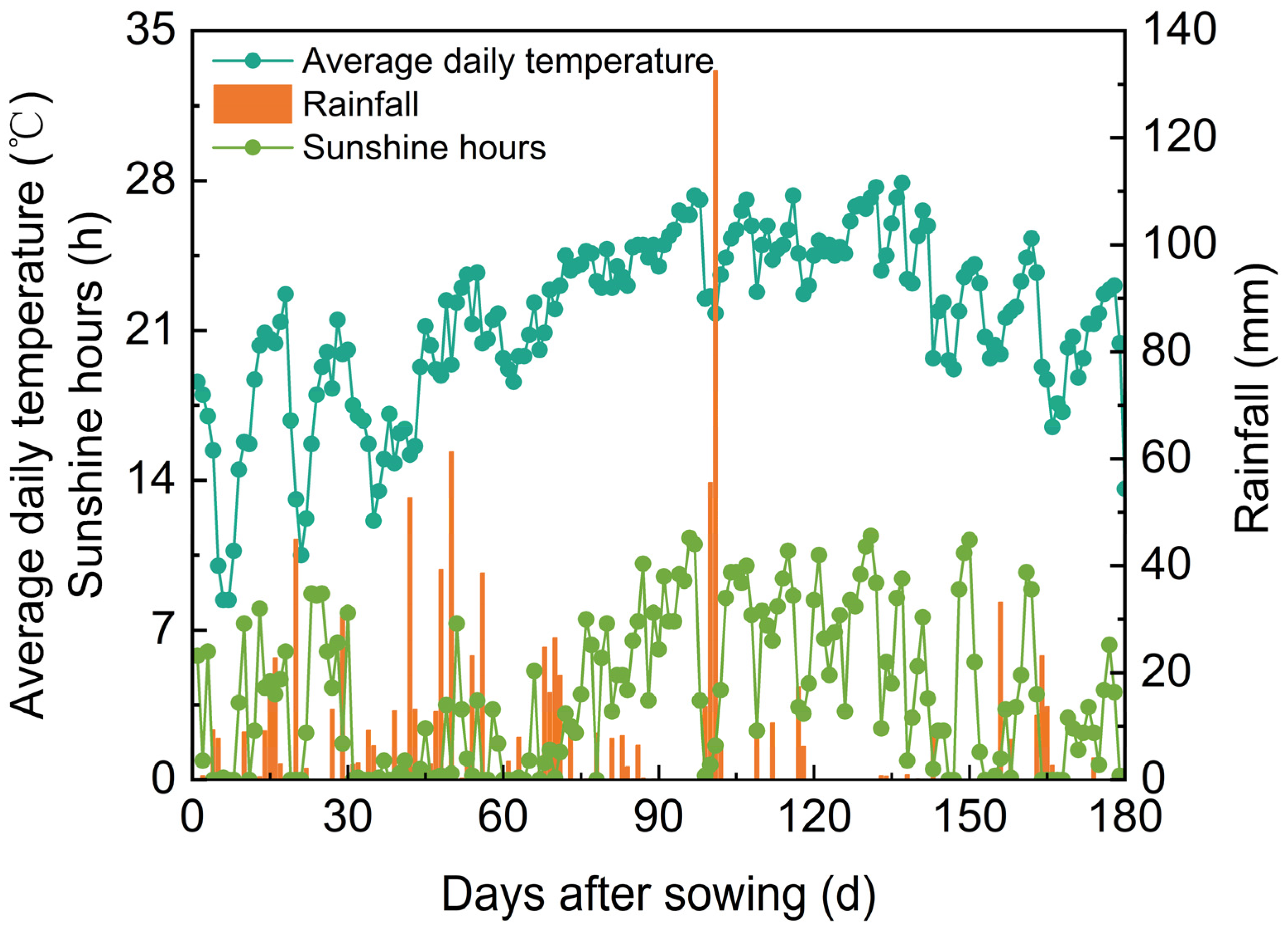

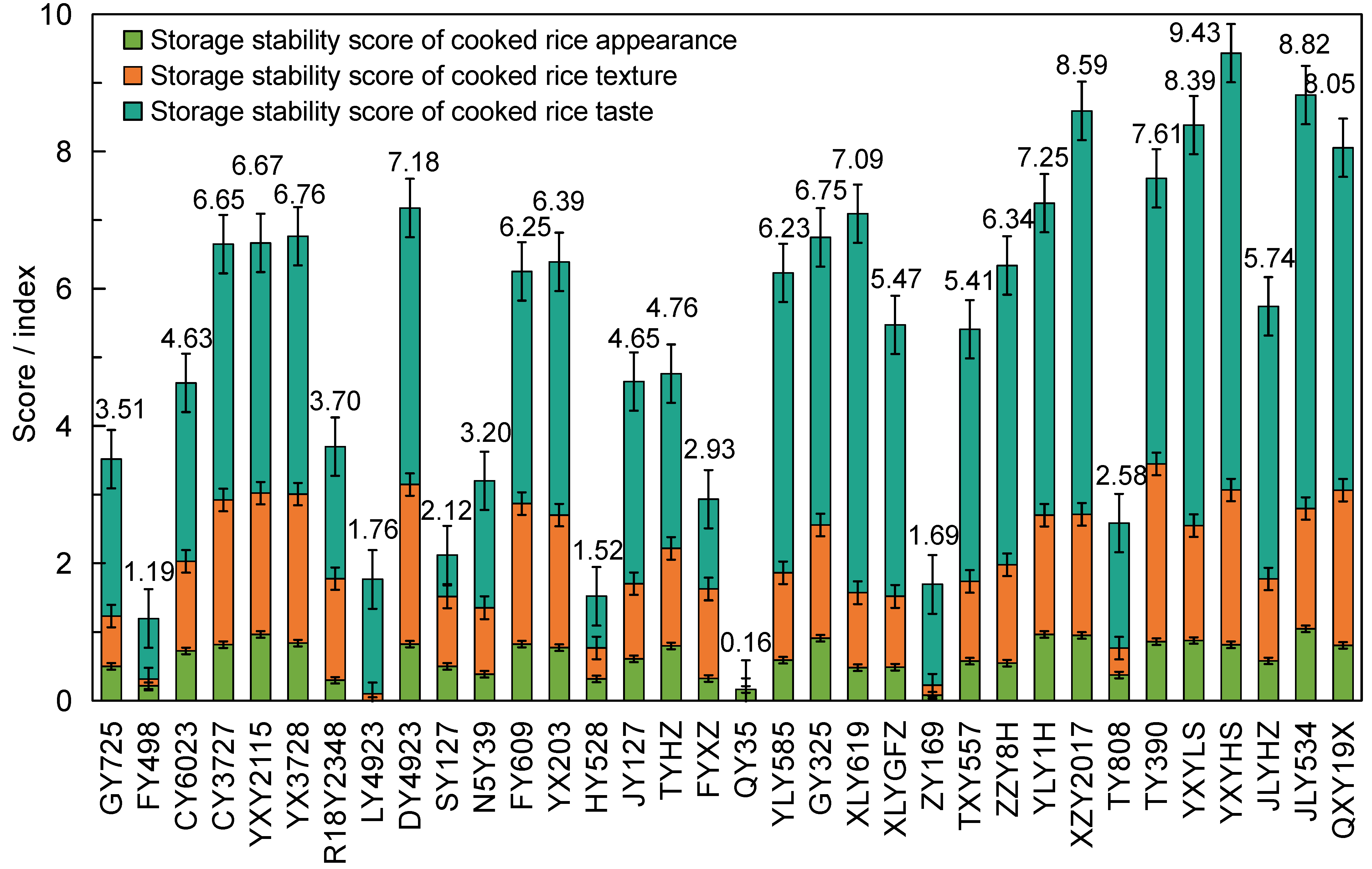
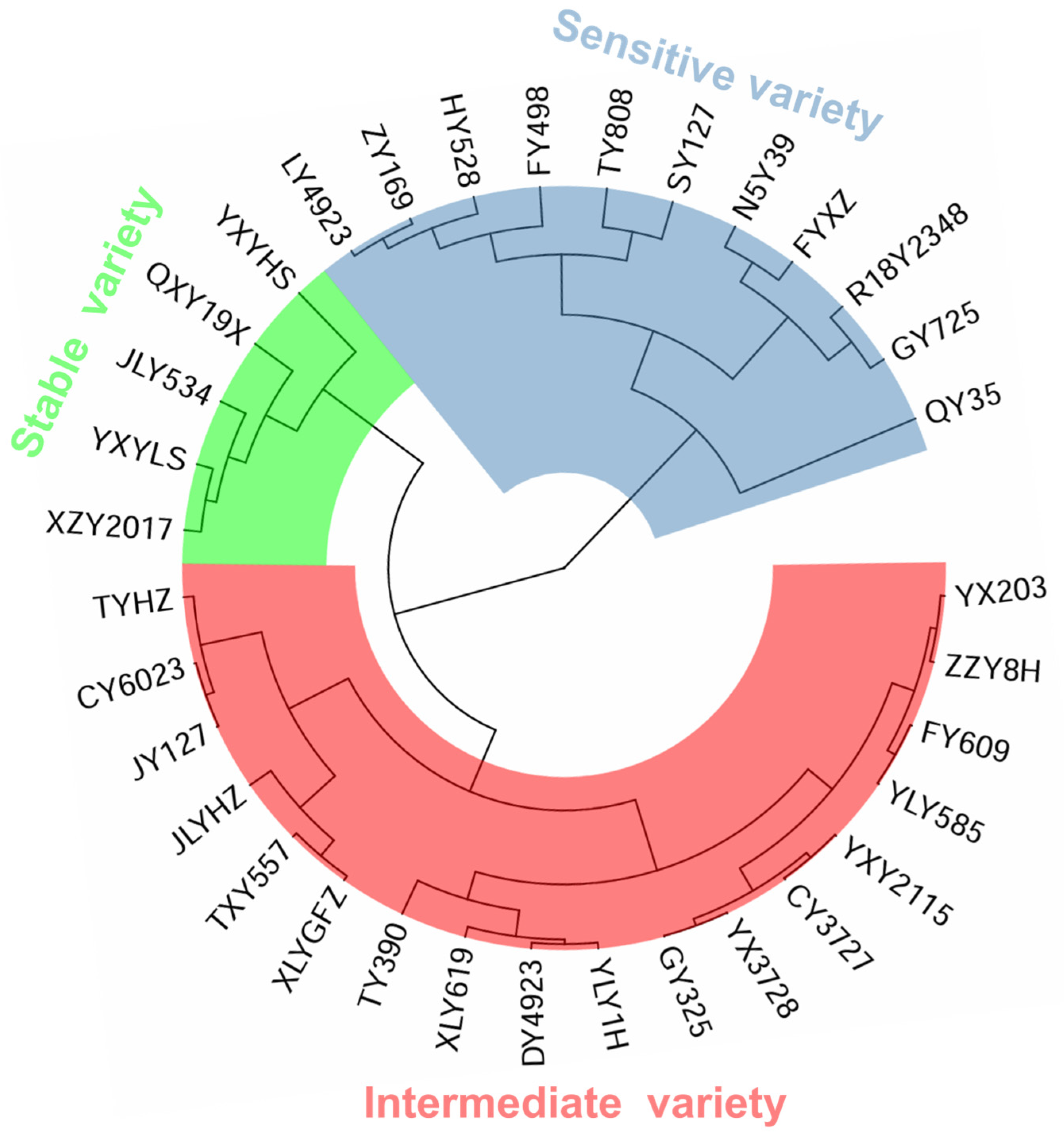
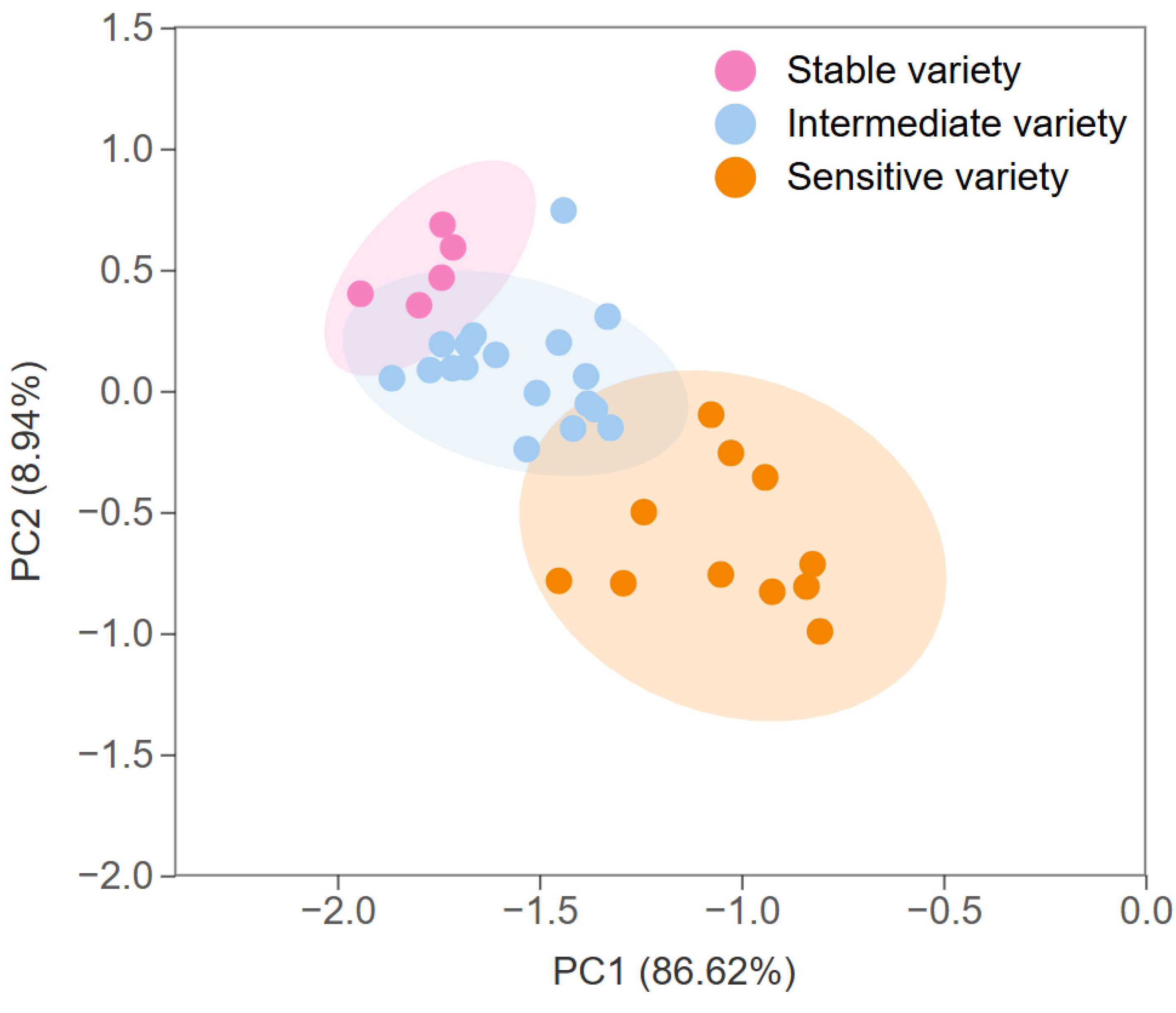
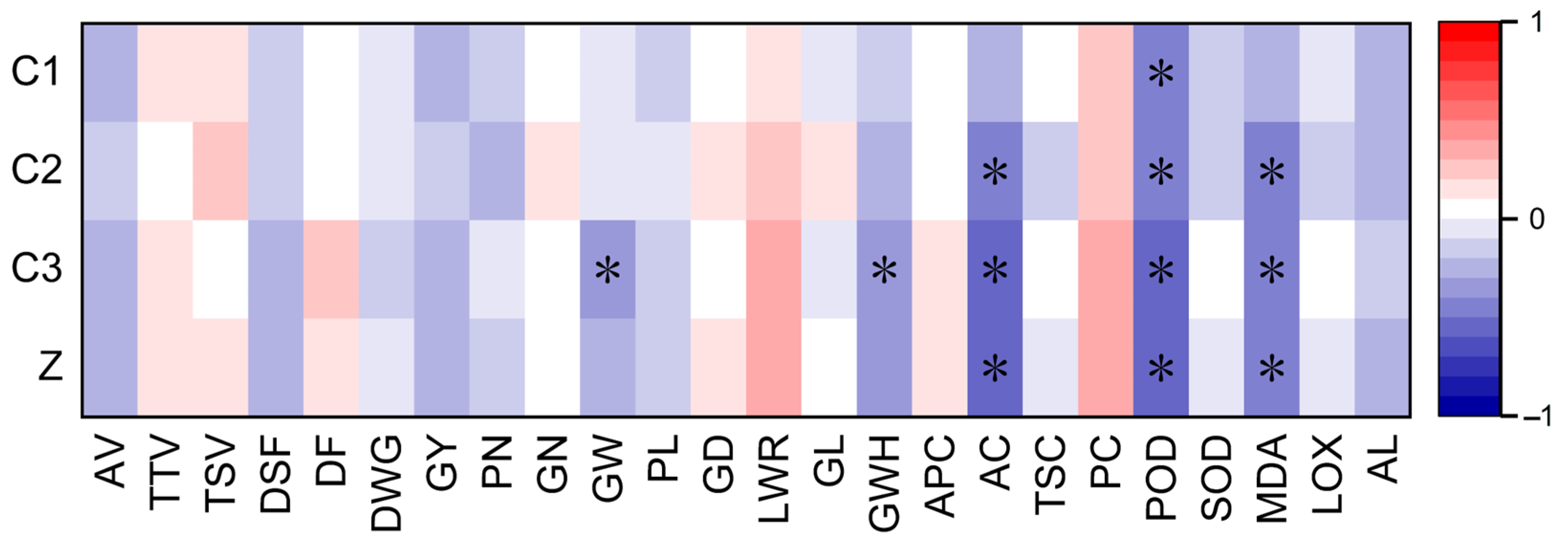
| Scale | Meaning |
|---|---|
| 1 | Equal importance of both indicators |
| 3 | Slightly more important for one indicator compared with the other |
| 5 | Noticeably more important for one indicator compared with the other |
| 7 | Extremely more important for one indicator compared with the other |
| 2, 4, 6 | The median of two adjacent judgments |
| Order n | 1 | 2 | 3 | 4 | 5 | 6 | 7 | 8 | 9 |
|---|---|---|---|---|---|---|---|---|---|
| RI value | 0.00 | 0.00 | 0.58 | 0.90 | 1.12 | 1.24 | 1.32 | 1.41 | 1.45 |
| Range | Mean Value | CV (%) | |
|---|---|---|---|
| The appearance value of fresh rice after cooking | (5.70, 7.75) | 6.82 | 6.98 |
| The appearance value of stored rice after cooking | (3.70, 6.55) | 5.50 | 12.3 |
| Variable amplitude of the appearance value (%) | (−40.6, −3.13) | −18.7 | −52.6 |
| The texture value of fresh rice after cooking | (5.20, 7.35) | 6.47 | 7.88 |
| The texture value of stored rice after cooking | (3.55, 6.20) | 5.24 | 13.5 |
| Variable amplitude of the texture value (%) | (−36.1, −3.56) | −19.1 | −45.8 |
| The taste value of fresh rice after cooking | (55.5, 74.3) | 65.1 | 6.66 |
| The taste value of stored rice after cooking | (43.1, 67.2) | 55.9 | 10.9 |
| Variable amplitude of the taste value (%) | (−28.8, −0.80) | −14.2 | −51.6 |
| C1 | C2 | C3 | |
|---|---|---|---|
| C1 | 1 | 1/3 | 1/5 |
| C2 | 3 | 1 | 1/3 |
| C3 | 5 | 3 | 1 |
| Storage Stability of Cooked Rice Appearance | Storage Stability of Cooked Rice Texture | Storage Stability of Cooked Rice Taste | |
|---|---|---|---|
| Weight value | 0.105 | 0.259 | 0.637 |
| Variety Type | Index | Mean Value | Variable Amplitude (%) | CV (%) |
|---|---|---|---|---|
| Stable variety | Amylose starch content (%) | 17.0 | (16.3, 17.7) | 3.07 |
| Peroxidase activity (U/g) | 18.4 | (12.6, 25.8) | 23.9 | |
| Malondialdehyde content (%) | 3.23 | (2.90, 3.38) | 5.70 | |
| Intermediate variety | Amylose starch content (%) | 17.8 | (15.4, 19.8) | 7.22 |
| Peroxidase activity (U/g) | 23.1 | (13.8, 31.1) | 19.0 | |
| Malondialdehyde content (%) | 3.30 | (2.49, 3.55) | 6.43 | |
| Sensitive variety | Amylose starch content (%) | 19.4 | (15.3, 22.9) | 13.2 |
| Peroxidase activity (U/g) | 28.7 | (14.0, 41.8) | 23.5 | |
| Malondialdehyde content (%) | 3.45 | (3.23, 3.66) | 4.55 |
Disclaimer/Publisher’s Note: The statements, opinions and data contained in all publications are solely those of the individual author(s) and contributor(s) and not of MDPI and/or the editor(s). MDPI and/or the editor(s) disclaim responsibility for any injury to people or property resulting from any ideas, methods, instructions or products referred to in the content. |
© 2024 by the authors. Licensee MDPI, Basel, Switzerland. This article is an open access article distributed under the terms and conditions of the Creative Commons Attribution (CC BY) license (https://creativecommons.org/licenses/by/4.0/).
Share and Cite
Tian, J.; Ji, G.; Zhang, J.; Luo, D.; Zhang, F.; Li, L.; Jiang, M.; Zhu, D.; Li, M. Variety Screening and Characterization Analysis of Storage Stability of Eating Quality of Rice. Foods 2024, 13, 4140. https://doi.org/10.3390/foods13244140
Tian J, Ji G, Zhang J, Luo D, Zhang F, Li L, Jiang M, Zhu D, Li M. Variety Screening and Characterization Analysis of Storage Stability of Eating Quality of Rice. Foods. 2024; 13(24):4140. https://doi.org/10.3390/foods13244140
Chicago/Turabian StyleTian, Jinyu, Guangmei Ji, Jiafeng Zhang, Danqiu Luo, Fang Zhang, Lijiang Li, Mingjin Jiang, Dawei Zhu, and Min Li. 2024. "Variety Screening and Characterization Analysis of Storage Stability of Eating Quality of Rice" Foods 13, no. 24: 4140. https://doi.org/10.3390/foods13244140
APA StyleTian, J., Ji, G., Zhang, J., Luo, D., Zhang, F., Li, L., Jiang, M., Zhu, D., & Li, M. (2024). Variety Screening and Characterization Analysis of Storage Stability of Eating Quality of Rice. Foods, 13(24), 4140. https://doi.org/10.3390/foods13244140





